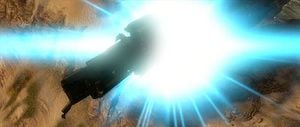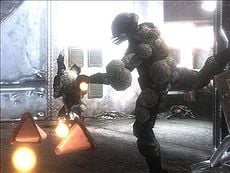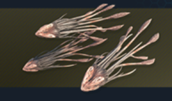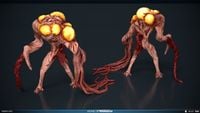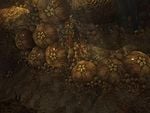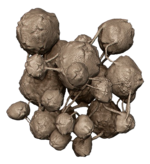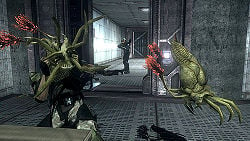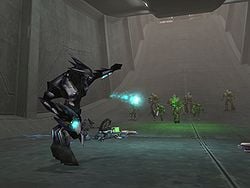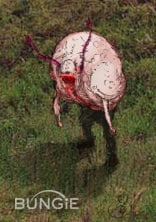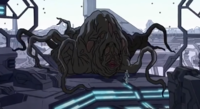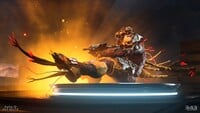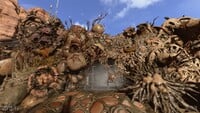Flood: Difference between revisions
From Halopedia, the Halo wiki
m (→Gallery) |
BaconShelf (talk | contribs) m (→Infester Forms) |
||
| Line 247: | Line 247: | ||
======Infester Forms====== | ======Infester Forms====== | ||
[[File: | [[File:Enc22 Infester.png|thumb|An Infester form.]] | ||
{{Main|Flood infester form}} | {{Main|Flood infester form}} | ||
These forms attack and infect vehicles. | These forms attack and infect vehicles. | ||
Revision as of 06:50, July 21, 2024
| Flood | |
|---|---|
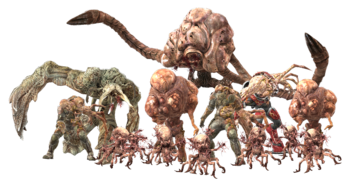
| |
| Biological overview | |
|
Latin name: |
Inferi redivivus |
|
Diet: |
Parasitic |
| Physical information | |
|
Avg. height: |
Variable (depending on host) |
|
Avg. weight: |
Variable (depending on host) |
|
Distinctions: |
Variable |
| Sociocultural information | |
|
Homeworld: |
Extragalactic |
|
Variable | |
|
Notable individuals: |
|
|
Also known as: |
|
- "One single Flood spore can destroy a species."
- — Rtas 'Vadum[2]
The Flood, designated as LF.Xx.3273 by the Forerunners (Latin Inferi redivivus[3] meaning "the dead reincarnated"[4]) and referred to as the Parasite[5] and the infection[6] by the Covenant, is a species of highly virulent parasitic organisms that reproduce and grow by consuming sentient lifeforms of sufficient biomass and cognitive capability. The Flood was responsible for consuming most of the sentient lifeforms in the galaxy - including the vast majority of Forerunners - during the Forerunner-Flood war in ancient past, prompting the activation of the galaxy-sterilizing Halo Array in 97,445 BCE.[7]
Originating as a corrupted form of the galaxy's most ancient custodians (the Precursors)[8] the Flood reproduces and spreads by infecting other organisms, hijacking their bodies and nervous systems in order to transform them into one of many specialized forms. Through infecting sentient lifeforms, the Flood assimilates their memories and intelligence, and the species becomes collectively more intelligent as a result. Because of their frighteningly rapid growth rate, as long as enough hosts of sufficient biomass and intelligence are available, the Flood is effectively unstoppable.
All Flood forms share a single consciousness, which becomes progressively more intelligent and sophisticated with every sentient host that is assimilated. When enough hosts have been infected, the Flood consciousness becomes a Gravemind - a self-aware, highly intelligent entity that strategically commands all Flood forms in an outbreak. Due to this group consciousness, the Flood as a whole is more accurately described as a single, transsentient superorganism rather than a collection of individuals directed by one or more controlling beings. In the absence of a Gravemind, the Flood possesses only basic coordination; they are incapable of forming complex strategies, and focus solely on attacking and infecting nearby sentient organisms. This stage of a Flood outbreak is known as the Feral Stage. At this stage, the Flood seek to create an assembly of biomass, calcium, and nervous system reserves, which leads to the creation of a Flood hive and the beginnings of a proto-Gravemind. The nature of the Flood's collective consciousness is similar to that of a hive mind, the Flood act as a unified entity, with no individuality that is inherent to other species; each vessel of the Flood works tirelessly to aid in the propagation of their species.[3]
The Flood presents a highly variable and unconventional threat in combat, as it can infect and mutate dead or captured opponents into a myriad of deadly forms, effectively growing stronger as it weakens enemy forces. They are widely considered to be the greatest threat to the existence of life (or, more accurately, biodiversity) in the Milky Way galaxy.
History
Origins
- "Our urge to create is immutable; we must create. But the beings we create shall never again reach out in strength against us. All that is created will suffer. All will be born in suffering, endless grayness shall be their lot. All creation will tailor to failure and pain, that never again shall the offspring of the eternal Fount rise up against their creators. Listen to the silence. Ten million years of deep silence. And now, whimpers and cries; not of birth. That is what we bring: a great crushing weight to press down youth and hope. No more will. No more freedom. Nothing new but agonizing death and never good shall come of it. We are the last of those who gave you breath and form, millions of years ago. We are the last of those your kind defied and ruthlessly destroyed. We are the last Precursors. And now we are legion."
- — The Gravemind to Catalog in the endgame of the Forerunner-Flood war.[8]
Over ten million years before present day, a civilization of supremely advanced beings known as the Precursors thrived in the cosmos. Having assumed the Mantle - the responsibility for the guardianship of all life in the galaxy - they seeded numerous worlds with life, bringing forth a wide range of sentient species across the galaxy. Under their guardianship, numerous intelligent species developed and flourished, including the Forerunners and humanity. The Precursors would eventually choose humanity to be the rightful successors to their Mantle, while judging the Forerunners unworthy. Refusing to accept their creators' judgment, the Forerunners staged a massive rebellion against the Precursors.[8]
The ensuing conflict ended with the Forerunners successfully wiping out all but a few Precursors.[9] The few Precursors that escaped from (or were spared by) the Forerunners either went into suspended animation or transmuted themselves into dust that would regenerate into their past forms at a later time. However, over time the dust became defective, creating sickness, disease and biological mutations in other organisms that came into contact with it. With this new form — the earliest stage of the Flood — the Precursors vowed that none of their creations would rise against them again.[8] A significantly mutated Precursor, one that would later be known as the last surviving one of its kind,[10] was sealed in a Precursor stasis capsule and placed in a small, ravaged planetoid at the galaxy's edge around 9,000,000 BCE.[11] This being, later known as the Primordial, would eventually reveal the nature of the Flood to those willing to know the truth.[8]
First outbreak
Antecedents
The Flood, as it is known in modern times, first appeared in the galaxy some time prior to 107,445 BCE, after ancient humans came into contact with the Precursor dust. This fine, desiccated powder had been stored in millions of glass cylinders placed aboard automated starships,[12] bound toward the margins of the Milky Way galaxy from the direction of the Large Magellanic Cloud.[13] Forthencho came to believe that the Primordial, despite its hibernating state at the time, may have been responsible for remotely triggering the movement of these ships.[14] However, over a span of ten million years, the substance had slowly deteriorated, along with the ships themselves failing.[12]
The crashed remains of these ships were discovered by ancient humans on both inhabited and deserted worlds near the border of intergalactic space, a region of the galaxy to which humans expanded early on in their history. Inside the ships, humanity found the capsules filled with powder, which their tests told them consisted of inert, short-chain organic molecules of unknown purpose.[12] Humanity studied the material and deemed it to be harmless, but noted that it had psychotropic effects on lower animals. Small dosages were administered to Pheru, popular domestic animals among humans and San'Shyuum, which resulted in more docile behavior.[15] Unbeknownst to the humans or San'Shyuum at the time, the powder was altering the genetic code of the Pheru, manifesting as improved behavior while slowly changing other aspects of their genome.[12]
Emergence
After the humans had exposed the Pheru to the powder for several centuries, more disturbing changes appeared. Pheru treated with the powder began exhibiting furry growths and fleshy protrusions, which other Pheru were compelled to consume. Shortly afterward, the Pheru began suffering widespread abortions and genetic deformities, and many were euthanized or released into the wild. Soon afterward, the humans and San'Shyuum who had been in the presence of the altered Pheru began to exhibit some symptoms of the powder-induced "disease". Affected on a psychological level by the strange illness, infected victims began to consume the sick Pheru, and anything they touched became infected while parts of themselves that were discarded, such as tissue and limbs, also became vectors for the disease. The afflicted then moved on to cannibalism and sacrifice of the infected, inducing a sacrificial individual to grow to prodigious size and then forcing uninfected individuals to consume them while they were still alive. During this time, the infection passed from human to San'Shyuum and human to human, but rarely San'Shyuum to human. The infected humans and San'Shyuum proceeded to spread the disease into other systems, which furthered the scope of the Flood outbreak.[12]
At this point, the Flood infestation, which had previously been predominantly a mind and behavior-altering affliction with only relatively minor physical changes, began to reshape its victims into a variety of forms designed to gather victims, engage in combat, and to rapidly consume useful biomass and other resources.[12]
Spread and withdrawal
The infection quickly spread through both human and Forerunner space. Attempts to quarantine infected worlds and systems failed, leading to the Flood soon infecting hundreds of worlds in fifteen systems.[12] In an effort to halt the Flood's continuing spread, human fleets began destroying Flood-infested Forerunner ships and cleansing Forerunner planets where Flood infestations were detected. Forthencho, the commander of the human fleets, chose not to warn the Forerunners in advance of these actions to prevent giving the Flood time to expand.[16] In turn, many Forerunners believed that the Flood was a fiction meant to hide humanity's expansionist aims. Ultimately, the Forerunners interpreted humanity's tactics as acts of aggression, leading to the Human-Forerunner wars.[12]
With humanity severely weakened from the Flood infection and now fighting a two-front war, the Forerunners were surprised at the ease of their earliest victories against the humans. However, apparently without warning, the Flood began to retreat from its assault on humans. Forerunner ships found healthy human worlds within sectors of Flood infestation, leading Forerunners to conclude that humanity had developed a natural resistance, immunity or cure to Flood infection.[17] However, no immunity or cure to the Flood existed; the Flood had chosen to stop infecting humans.[18] The Didact later speculated that the Flood's intent was to prevent humanity's extinction at the hands of the Forerunners by making it appear as if humans held a solution to Flood infection.[19]
At this time, the Forerunners also first came into contact with the Flood. The parasite devastated many of their fleets, before its deliberate recession from the galaxy tipped the scales in the Forerunners' favor, allowing them to sterilize any Flood infestation they came across in several thousands of worlds across the galactic border.[17] While recognizing the legitimate concern of a Flood resurgence in the future, the Forerunners had difficulty extracting any intact specimens of the parasite for study; approaching the threat with appropriate caution, the Warrior-Servants directly cauterized any active infestations they encountered. From the scattered remains recovered for analysis, the Forerunners discovered that AIs that had been in contact with the Flood had been corrupted beyond repair by what the Forerunners would come to know as the logic plague, essentially the data equivalent to Flood infection.[17] No fully intact specimen of the Flood could be found among the Pheru, humans, or San'Shyuum, as they had methodically destroyed any sign of infection, including all the original carrier vessels that they had discovered.[20] Any remaining Flood were believed to have fled the galaxy aboard infected ships,[20] and the Flood was not seen again for nearly ten thousand years.
While they managed to regain some of their strength once the Flood began to recede, humanity still stood against the Forerunners in the later stages of the conflict. Their campaign against the Flood had worn their resources thin, while the Forerunners led by the Didact had managed to entrench their forces in advantageous positions which proved too powerful for humans to hold against.[20] System by system, the humans fell back to their capital, Charum Hakkor, where they were finally defeated. After losing the conflict, the Forerunners devolved humanity and exiled them to their homeworld while erasing all signs of human achievement from the galaxy.
Interim
Due to the lack of evidence, most Forerunners were unaware of the existence or of the true nature of the Flood, and many dismissed it as a simple excuse for humanity's aggressive expansion before and during the initial arrival of the Flood. However, several high-ranking Forerunners were fully informed of the threat, and in secret began developing countermeasures should the Flood ever return. This became the source of a major political strife, with the Builders proposing the construction of an array of superweapons - Halos - while the Warrior-Servants led by the Didact championed a more conventional strategy of carrying out precision military campaigns from planet-sized fortresses known as shield worlds. The Didact eventually lost to the Builders and the entire Warrior-Servant rate was marginalized, with their fleets and forces disbanded or forced to submit under Builder control. This proved to have been a grave mistake, as the Forerunners found themselves ill-prepared to fight off the Flood after the parasite returned to the galaxy.
Realizing that the Flood stood a significant chance of wiping out all sentient life and the prospect of using the Halos to stop them, the Lifeworker race of the Forerunners began a "Conservation Measure", researching the Flood while cataloging and preserving the galaxy's species aboard a number of facilities related to the Halo Array, mainly an extragalactic installation known as the Ark.
Forerunner-Flood war
- Main article: Forerunner-Flood war
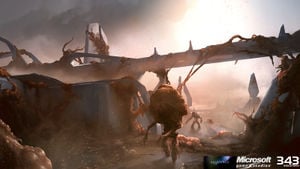
- "It fed on intelligent life and, in doing so, became ever more intelligent itself. The Flood was unique; it used their very strength against them."
- — Cortana on the Forerunners' war against the Flood.
The Flood reappeared as a viable threat in the galaxy when they were first encountered by the Forerunners on the planet Seaward. Initially, the Forerunners severely underestimated the potential threat that this parasitic lifeform posed, and used tactics more suited to disease control than actual warfare. By the time the infection had begun to spread, the Flood had become a much deadlier and more intelligent foe. While at first the Flood had demonstrated a lack of even rudimentary strategic ability, the parasite quickly began to amass biomass and create Graveminds, Flood forms that embodied a collective intelligence for the Flood species, and that could coordinate the Flood swarms in attacks against the Forerunner fleets using all Flood forms within the vast range of their seemingly telepathic control.[21]
A common tactic used by the Flood was to use huge numbers of unarmed civilian vessels to penetrate planetary defense groups, bypassing the Forerunners' orbital fleets, and infesting the planet and its populace below. The sheer numbers of Flood forms on the planets overwhelmed Forerunner ground forces. Billions of forms were dedicated to planetary assaults, and every member of the Forerunner population was a potential Flood host. These tactics were demonstrated in the Flood's attacks on numerous worlds, including LP 656-38 e and DM-3-1123b.[21] In desperation, the Forerunner armada was ordered to commence full planetary bombardment on infested worlds, although at a great cost - many Forerunners were unable to be evacuated before the bombardment commenced, leaving the Forerunner military with shallow victories against the Flood. In events where the naval garrisons were unable to commence bombardment, major Forerunner population centers were seen to activate localized weapons of mass destruction, effectively committing mass suicide, but stopping the growing infestation.[21]
Thereafter, the Forerunners realized that conventional naval tactics were unable to stem the growing tide of the Flood, and decided to pin their hopes of defeating the Flood on more extreme measures. While the Forerunners initially deployed robotic Sentinel drones to fight against and contain the Flood, almost immediately afterwards, the Forerunner Fleet Command contemplated "Premature stellar collapse": using naval battle groups to send stars into supernovae that would engulf their planetary systems and prevent any possibility of Flood infection and destroy all Flood present in the system.[21] As a further setback to the Forerunners, an extended dialog with the Primordial provoked Mendicant Bias, the Contender-class AI in charge of the Forerunner defense, to succumb to the Flood's logic plague and turn its vast resources against its masters. While the Primordial's physical body was eventually destroyed, it's consciousness was either consumed or transferred to the Gravemind, granting the Flood previously unprecedented intelligence and power.[22]
Final decade
The Flood grew exponentially, spreading from system to system with the intent to infect the Forerunner population, not to wage war with Forerunner battle groups which were poorly adapted to such strategy. As the Flood spread further, entire planetary biospheres were converted to Flood biomass. These planet-sized key minds, locuses of Gravemind intelligence that began to outcompete the Forerunners through raw computational might alone.[23][24] The logic plague continued to take on more adaptive forms, defying all defenses the Forerunners devised and eventually spreading itself between AIs and data networks. As the Forerunners relied significantly on AI automation in combat, this severely hindered Forerunner military efforts against the Flood. Adding to these difficulties was the disturbing revelation that the Flood was capable of manipulating Precursor technology: towards the close of the war, the Flood began to appropriate Precursor megastructures such as the star roads, wielding the previously-inert strands to pummel Forerunner planets and naval forces. This ability was a result of the Flood's Precursor origins; being corrupted Precursors, they could tap into neural physics and activate Precursor artifacts. The proliferation of high-level key mind nodes also enabled the Flood to use the Precursors' neural physics-based superluminal transit, which in turn encumbered Forerunner slipspace travel. Towards the end of the infestation, Forerunners noted that space itself seemed to become hostile and unpleasant from mere perception, an artefact of Flood-based Neural Physics. [23]
The Halos' firing
- Main article: Great Purification
The Forerunners employed countless measures to contain the Flood outbreak, all of which failed. Finally, the Forerunners were forced to a Pyrrhic solution: using an array of seven ring-shaped megastructures collectively known as the Halo Array as superweapons, the Forerunners would purge the galaxy of all sentient life. Because the Flood were parasitic, and their survival was directly linked to the presence of potential hosts (and in particular hosts capable of sentience) the Forerunners reasoned that eliminating all potential Flood hosts would render the parasite unable to grow and spread, and eventually cause it to starve to death. Additionally, as a result of the Master Builder's test of a Halo at Charum Hakkor, it was found that the Halo Effect unintentionally caused the complete destruction of artefacts of Neural Physics. This was likely a byproduct of how the Halo Effect was designed to destroy any and all forms of neurological structure subjected to it.[25] The decision led to political battles and even a civil war, but after exhausting every countermeasure, the Forerunners activated the Halos in 97,445 BCE.
As a result of the firing of the seven Halo installations, the surviving Flood were successfully contained and eventually died out. The only surviving specimens were contained in state-of-the-art, high-security Forerunner research facilities, such as the Halo installations, certain Shield Worlds, and the Threshold gas mine. All Precursor artifacts and structures, composed and maintained entirely using Neural Physics were also destroyed and left no trace.[26] Many sentient species throughout the galaxy (including humanity) survived the firing of the Halo Array, having been safely relocated beyond the galaxy by the Forerunners on the Ark.
During their expansion throughout the Orion Arm, the Covenant would find and occasionally release the Flood, employing Zealots and their Temple Wraiths to contain the outbreaks.[27][28]
Outbreak on the Etran Harborage
- Main article: Battle of the Etran Harborage
Thousands of years after the end of the Forerunner-Flood war, the human ship UNSC Spirit of Fire jumped from Arcadia to follow the signal of Professor Anders, who had been captured by the Covenant. They were led to an unknown planet, which happened to be a Forerunner shield world. Containment measures on this planet had failed catastrophically, and the entire surface of the megastructure was choked with Flood biomass. Ground forces were deployed to investigate the presence of unknown hostiles sighted by the ship's radar. After fighting their way through Covenant forces, Sergeant Forge and several Marine squads were attacked by the Flood.
After successfully defeating the Flood forces, the UNSC forces created a firebase in the area that Anders' signal appeared to be coming from. The humans eventually tracked the signal to a massive Proto-Gravemind attached to several Flood colonies. The Proto-Gravemind had duplicated Anders' signal, possibly in hopes of infecting the humans and spreading beyond Etran Harborage. It was discovered that killing a Flood colony weakened the Proto-Gravemind and SPARTAN-II Red Team, with help from the firebase, destroyed the Proto-Gravemind.
The Flood responded by launching a massive attack on the Spirit of Fire's Alpha, Bravo and Charlie Platoons to avoid them returning to the ship. Despite massive Flood resistance, forces from the Spirit of Fire were able to rescue the platoons before their firebase was overrun by the Flood.
With the Proto-Gravemind dead, the smart-AI Serina was able to reacquire Anders' actual signal, which led to an ocean under which a docking port leading to the interior shield world was located. During the Spirit of Fire's descent, the outer surface of the ship was infested by the Flood. With the aid of Sentinels and "cleansing rings" controlled by the installation's AI, the Spirit of Fire crew were able to cleanse the ship and proceed into the shield world.
Within, the UNSC forces discovered that the Flood had managed to infest the interior of the shield world as well, though not to as massive of a degree as the surface planet itself. While rescuing Anders, Forge had to save her from three pod infectors and ran into some trouble with Flood forces on his following missions, though not to the massive extent they had been seen on the exterior planet.
In order to prevent the Covenant from getting their hands on Etran Harborage's fleet of Forerunner Sojourner-class dreadnoughts, a plan was created to use the reactor from the Spirit of Fire's Shaw-Fujikawa Translight Engine to induce the shield world's artificial star to go supernova. The plan was a success and Etran Harborage was destroyed. The explosion obliterated the Flood on the planet, along with the Covenant forces and the Forerunner fleet.[29]
Brief recurrence
- Main article: Outbreak on the UNSC Spirit of Fire
On January 1, 2537, six years after the events on Trove, a Flood outbreak was initiated aboard the UNSC Spirit of Fire by a Pod infector that had managed to remain hidden aboard the ship. As the Flood threatened to breach quarantine, Serina awoke Jerome-092 who, with the aid of Professor Ellen Anders, was forced to exterminate all infected crew members, ensuring the survival of the Spirit of Fire and its remaining crew. All traces of the Flood parasite aboard the Spirit of Fire were erased.[30]
Revival of the Flood
- Main articles: Battle of Installation 04, Outbreak at the Containment Facility
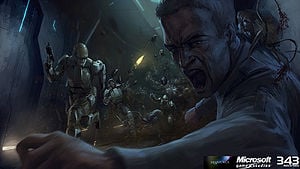
- "The only way to stop the Flood is to starve them to death."
- — Cortana to John-117 and 343 Guilty Spark.
Although the first firing of the Halo Array starved the Flood that were at large in the Milky Way Galaxy, Flood specimens were kept in stasis within installations around the galaxy, including Installation 04 and various Forerunner research facilities. This would prove to be a grave mistake, as both humanity and the Covenant stumbled upon one of the abandoned Halo rings thousands of years after the firing of the Array. The UNSC AI Cortana, aboard the UNSC Pillar of Autumn, made what was presumed to be a "blind" jump through Slipspace (in reality, she used translated co-ordinates from a Forerunner artifact found on Sigma Octanus IV) to evade Covenant pursuers. This led both groups to Installation 04, and in turn, the Flood that were kept there in stasis. After the crash of the Pillar of Autumn on the Halo ring, piloted by Captain Jacob Keyes, the surviving crewmembers dug in for what they believed would be a long and brutal guerrilla campaign against the Covenant forces on the ring.
Meanwhile, the pursuing Covenant cruisers, among them the Truth and Reconciliation, amassed their ground forces on the surface, where they soon discovered an underground Forerunner Flood containment facility in the swamps of the ring. Due to the secure nature of the facility, the Covenant came to use it as a fortified base of operations and as a storage area for weapons and ammunition, oblivious to its true nature and purpose.
At some point, either through a malfunction in containment equipment or a blunder on the Covenant's part, the captive Flood forms within the facility's stasis chambers were released and attacked the Covenant forces inside. The Covenant had at least a rudimentary knowledge of what the Flood were capable of, and promptly locked the facility down and evacuated all personnel who survived the incident.
Keyes and his team were unaware of these events, and proceeded to move deep into the facility, ultimately coming across one of the unopened Flood containment chambers. Believing it was a weapons cache of some sort, the team unlocked the door, and were attacked and assimilated by the Pod infectors inside. Upon being informed of Keyes' disappearance, John-117 was deployed to Captain Keyes' last known location on the drop ship Echo 419, proceeding into the facility, only to find out that most of the Marines he had been assigned to rescue, including the Captain himself, had succumbed to the Flood.
These events brought knowledge of the Flood to the UNSC. In a war of losses, this was another grim revelation for humanity.[31]
Voyage of the Infinite Succor
- Main article: Skirmish on Infinite Succor
Shortly after their escape from the containment facility, Flood forces took control of a nearby crashed Spirit dropship, the Brilliant Gift and crashed it aboard the Covenant Mjern-pattern agricultural support ship Infinite Succor. The Flood quickly spread throughout the ship, infecting its crew and the animals from the vessel's hunting preserve. The Flood began building a Proto-Gravemind, intending to use the Infinite Succor to flee the Soell system and begin infecting other planets. The ship's Legate, the Minister of Etiology, locked out the Infinite Succor's primary systems while one of the crew's Unggoy managed to send out a distress call. Suspecting human involvement, particularly that of the Demon, Supreme Commander Thel 'Vadamee sent a Covenant Special Operations team led by Rtas 'Vadumee to retake the ship and eliminate the Demon if he were onboard. Quickly uncovering the true threat, Rtas programed the ship to make a slipspace jump into the system's star which would destroy the Infinite Succor and the Flood infestation onboard. Though Rtas succeeded, he was the only survivor.[32]
Assault
After the Flood's escape, the Covenant forces across Installation 04 were overwhelmed by the Flood's assault. While the Covenant were able to hold the line by using vehicular and air support, most of the weaker Covenant soldiers such as Unggoy and Kig-Yar succumbed easily to the Flood, and the few Sangheili who remained were outnumbered and thus infected. The UNSC, having a much smaller presence on the installation, found out about the Flood's might a short while later, when an ODST force engaged with the Covenant near Alpha Base, was ambushed by the Flood and suffered heavy casualties. However, one of the attacking combat forms, PFC Wallace A. Jenkins, who was one of the Marines in the original expeditionary mission to the supposed arms cache, was infected by a weak and elderly Pod infector whose powers of infection had been dulled by centuries of hibernation, making Jenkins' transformation into a combat form incomplete. Jenkins was still able to resist the pervasive Flood entity in his mind, and although incapable of articulate speech and with a physiologically devastated body, Jenkins was still able to betray the Flood through hand gestures during an interrogation with Major Antonio Silva, informing the UNSC Marine battalion that the Flood planned to assault the UNSC base from a series of underground catacombs underneath their current base of operations. In response to this intelligence, the UNSC moved to secure them, and prevented the Flood from staging another attack.[33]
During these developments, the ring's Sentinels failed to effectively contain the Flood, and because of this, the Covenant and the UNSC sustained heavy losses. The Flood occupied areas of the ring formerly held by the Covenant, although Covenant and Flood forces continued to wage war on the massive ice plains of the ring. Although the Covenant had the benefit of Shade stationary plasma turrets and vehicular/aerial support, the Flood had captured both UNSC and Covenant weapons and because of this had significant numerical superiority.
One of the UNSC personnel captured by the Flood was Captain Jacob Keyes, a brilliant naval strategist of the UNSC Navy. When he was infected, the Flood sensed that he held knowledge that would be especially useful to the Flood. Keyes knew the location of Earth, the birthplace and major stronghold of the human race, a planet with tremendous possible assimilation opportunities for the Flood. Instead of becoming a combat form, he was merged with at least four other victims into a massive, engorged proto-Gravemind aboard the Ket-pattern battlecruiser Truth and Reconciliation, a Covenant warship the Flood had taken over. While he was being incorporated into the proto-Gravemind, the Flood intelligence began to dig through his mind, searching his memories for the location of Earth. Captain Keyes successfully withheld information about Earth by constantly accessing information available on his command neural interface such as his name, rank, and serial number, until John-117 arrived. However, his arrival was too late, for Keyes was already dead, completely consumed by the Proto-Gravemind. It was at that time that John-117 was forced to punch a hole into Keyes' skull to obtain the Captain's CNI transponder.[34]
The Truth and Reconciliation was a major point of contention between the Covenant Special Operations units and the Flood. The Flood had decimated most of the Covenant crew and garrison on board, leaving only isolated pockets of resistance, mostly small numbers of terrified Unggoy and a few Sangheili aboard the vessel. However, below the Truth and Reconciliation, in a series of rocky canyons, the Covenant were much stronger in force, with large numbers of Sangheili augmented by Unggoy, Kig-yar, and Mgalekgolo, fighting off the Flood. The Covenant Council of Masters in charge of operations on Installation 04, however, were terrified by the Flood presence. Because the Covenant battlecruiser had been damaged in a previous space battle with the UNSC Pillar of Autumn, it had been grounded, awaiting repairs to its underbelly and plasma carrying conduits, for at least two days. After the Flood were discovered to be aboard the battlecruiser, the Covenant military leadership sent a Special Operations strike force to the Truth and Reconciliation to commence immediate emergency repairs, prepare it for lift-off into space and neutralize the Flood. These efforts, however, failed, with the Flood eventually retaking the vessel.
Later, the remaining UNSC Marine forces on the ring staged an assault on the Flood-held Truth and Reconciliation, and managed to neutralize most Flood forms on the cruiser in a swift assault, and prepared the battlecruiser for take-off with hastily completed emergency repairs to escape from the ring and return to Earth. However, there was tremendous risk if the Flood-infected vessel traveled to Earth, if there was even one Flood carrier form aboard, "Earth could fall," according to UNSC AI Wellsley, because of the Flood's exponential parasitic potential. Against orders, Marine First Lieutenant Melissa McKay destroyed the warship with whatever Flood forms were still aboard, killing hundreds of UNSC personnel, including an infected Jenkins, but saving Earth and possibly billions of lives from the Flood.[33]
Defeat
The Flood were interested in seizing space-capable vessels, in the hope of spreading the infection away from Installation 04 and across other systems; they attacked the UNSC Pillar of Autumn and cruiser Truth and Reconciliation for this reason. After the UNSC cruiser's crash-landing onto the ring, and after engaging over fifteen enemy warships previously to landing, it had been taken by the Covenant, although a UNSC strike team had managed to temporarily retake the bridge. On the third and final day of the Battle of Installation 04, however, the Covenant were able to gain control of the crashed warship while one of many Covenant patrols around the exterior of the Autumn was ambushed by the Flood and infected; upon the patrol's return to the vessel, the Covenant garrison was attacked by the infected Elite combat forms of the patrol group. The combat forms were able to scatter before they could all be destroyed, and a steady trickle of Flood continued to enter the Pillar of Autumn through vents and openings in the hull, waging a tedious guerrilla battle against the Covenant security force on board. On another occasion, the Flood attempted to enter through cargo containers but were foiled due to the quick thinking of the Unggoy Yayap.
Eventually, a force of Sentinels came on board, overwhelming the dwindling Covenant forces as the Flood began to attack the warship in full force, in the end almost completely obliterating the Covenant presence, and severely limiting the Sentinels' numbers on board. Despite their best efforts and enormous numbers, the Flood, Covenant, and Sentinels were unable to stop John-117 from detonating the wrecked warship's reactors, and escaping in a Longsword interceptor. The resulting thermonuclear detonation from the destabilized fusion reactor cores severed a portion of the ring world, ultimately destroying it and its capability to annihilate all sentient life, and simultaneously killed all remaining Flood on Installation 04, along with any other life forms that were still present on the ring.[33][31]
Outbreak on the Mona Lisa
- Main article: Skirmish on Mona Lisa
After the destruction of Installation 04, in October 2552, a human prison ship, the Mona Lisa, arrived in the Soell system and managed to retrieve surviving specimens of the Flood for study from the remains of Installation 04. They began to test the parasite on both human and Covenant prisoners, unaware of its lethality. Soon, the infection broke quarantine and the ship was infested by the Flood. The Flood absorbed the crew and prisoners, then began to build a proto-Gravemind in its engineering section. The infestation ended when Sergeant Zhao Heng Lopez and her marines from the UNSC Red Horse were sent to investigate the ship after retrieving a survivor from the ship. The Flood absorbed many of her marines, leaving her and a single Sangheili to fight for a single-occupant escape pod. The outbreak was most likely contained when the Red Horse destroyed the Mona Lisa using a Shiva-class nuclear missile.[35]
Threshold gas mine
- Main article: Raid on the Threshold gas mine
The Flood were also kept in a Forerunner-constructed gas mining facility suspended over Threshold, within at least one of the three arms of the station. A small Covenant special forces strike team, led by Special Operations Commander Rtas 'Vadumee and the Arbiter Thel 'Vadamee, were dispatched by the High Prophets to silence Sesa 'Refumee, the leader of a heretic faction, who was stationed within the mine. The heretics released the dormant Flood within the station in an attempt to halt the progress of the Spec-Ops team through the station.
The heretics' plan backfired as the Flood killed and infected many of their forces while failing to stop the Arbiter and his team. The Flood broke out of the station's arm and spread to the central core of the station, where they overwhelmed the heretics stationed there. Eventually, even the station's Sentinel forces were completely obliterated as the Flood spread to the upper levels of the station. The Flood were unable to escape the station, however, as the Arbiter managed to sever the cable attaching it to the Forerunner support structure far above, sending the gas mine plummeting to Threshold's liquid hydrogen core, destroying it.[36]
Battle of Installation 05

- Main article: Battle of Installation 05
On Installation 05, the Flood had been in a continual battle with the Sentinels after the initial firing of the Halos 100,000 years prior. Again, a secure facility was breached and a Flood form managed to escape, thus beginning the battle with Sentinels. While the infestation had been contained to a quarantine zone established outside the Installation's Library, and presumably was severely weakened due to a lack of fresh host bodies, the Flood had managed to keep a Gravemind form alive deep within the cavernous tunnels of the ring. With the arrival of the Covenant and pursuing UNSC forces, the Flood was able to grow its forces considerably and redouble its assault on the Installation's security forces.
The Flood, despite a significant vehicular and infantry presence in the Quarantine Zone surrounding the Library, were unable to deny access to the Covenant and the UNSC. Miranda Keyes managed to slip the In Amber Clad through the Forerunner Enforcer patrols, while the Covenant launched a ground attack, led by Thel 'Vadamee and involving a small team of Spec Ops Elites, using two anti-gravity gondolas to get to the index while attempting to control the gondolas and keep it from slipping into Flood or Sentinel hands. Later, the In Amber Clad was captured by the Flood.[37]
Fall of High Charity
- Main article: Fall of High Charity
John-117, who had arrived with Commander Miranda Keyes and Sergeant Johnson, met Thel 'Vadamee in the clutches of the Gravemind, the central controlling intelligence of the Flood hive, created from the combined intellect of tens of thousands of assimilated corpses. The Gravemind attempted to convince Thel, against his own beliefs, and through the use of the captured Monitor, 2401 Penitent Tangent, and the semi-revived and consumed Prophet of Regret to not activate the ring. Even though Thel was still unswayed, although in question of his religion, the Gravemind sent him and John-117 to search for the Activation Index to keep the Covenant from "turning" the "key," transporting John-117 to High Charity, and Thel to Delta Halo's Control Room.[38]
Taking advantage of the distraction that John-117's presence caused, as well as the ensuing Great Schism, the Gravemind took the opportunity to deliver itself, as well as a multitude of Flood underlings, onto the UNSC In Amber Clad and then slipspace jumped the UNSC ship directly inside High Charity, whereupon it immediately crashed into the city's superstructure to deliver its infectious cargo, while a wave of Flood-controlled Pelican dropships delivered Flood forms all over the city. The ill-equipped and distracted populace was no match for the Flood onslaught, and the Covenant Holy City was quickly overrun, with even the Prophet of Mercy falling victim to a Pod infector.[38]
The Flood soon spread to every district, and Flood spores began to infiltrate and overload the ventilation systems within High Charity; the whole city was becoming terraformed into a gigantic Flood hive. The Gravemind regularly rebutted the words of comfort the Prophet of Truth regularly delivered to the city’s population over the comm system, to sadistically instill more panic and unease. John-117, having successfully stayed in front of the wave of Flood running rampant in the streets, stowed away on the Forerunner Dreadnought that was leading Truth's fleet to Earth. Cortana, who had to stay behind to detonate In Amber Clad's engines should the situation arise and Installation 05 be fired, was left in the clutches of the Gravemind, who could potentially learn all possible human knowledge from her, including the entire knowledge directly received from Forerunner systems aboard Installation 04.[39][40]
Earth, the Ark, and the Flood's defeat
- Main articles: Outbreak on Earth, Battle of Installation 00
At the conclusion of the Battle of Voi, with the Prophet of Truth activating the Portal and the Jiralhanae fleet escaping to the Ark, a Flood-infested Covenant cruiser appeared out of Slipspace, having penetrated the Elites' blockade of High Charity and crash landed into the city of Voi in an effort to spread the parasite.[41] In order to prevent the Flood from escaping and infecting the entire planet, Commander Miranda Keyes ordered John-117 to detonate the cruiser's reactors and search the ship for Cortana, causing the city of Voi to be destroyed and the Flood there eliminated. As John-117 and Thel 'Vadam fought their way to the ship, the Sangheili assault carrier Shadow of Intent under the command of Rtas 'Vadum arrived and deployed Sangheili task force to aid UNSC marines. John-117, with the help of the Sangheili, was able to battle through the Flood forces, including the newly encountered Flood Pure Forms to reach the crashed cruiser where he found a message from Cortana. Upon this discovery, 343 Guilty Spark arrived, pledging his assistance to the Reclaimers. With the Flood spreading, John-117 boarded a Phantom while the Sangheili went on to glass the infected areas. The remaining Sangheili forces, fulfilling their mission of removing the Flood from Earth, retreated back to the Shadow of Intent, along with Cortana's message and Guilty Spark.[2]
With the assistance of 343 Guilty Spark, Cortana's painful message was repaired, revealing a solution to the Flood menace on the Ark. To Lord Hood's disapproval, Miranda Keyes led UNSC forces allied with Sangheili forces through the Portal at Voi to the Ark.[2]
On the Ark, while the Sangheili and human forces were attempting to infiltrate Forerunner shield control centers and lower the shield surrounding the Ark's Citadel, the infested High Charity made a slipspace jump and smashed into the Ark, releasing the Flood onto the superstructure. The Gravemind then made a brief alliance with the Master Chief and the Arbiter, Thel 'Vadamee, in order to stop the Prophet of Truth from activating the Halo Array, providing Flood backup to their assault on the Citadel. Once Truth was dead, however, the Gravemind treacherously ordered the Flood to turn against the two heroes. The Chief and the Arbiter escaped, however, with some assistance from the Sentinels, who were able to help subdue the Flood with ease. As they escaped the Flood, the Chief and the Arbiter discovered a replacement Halo ring rising from the Foundry and realized that Cortana's plan to stop the Flood was to fire the new installation at the Ark, an act that would sterilize the local infestation while leaving the Milky Way galaxy unharmed.[42]
In order to fire the new Halo, the Master Chief ventured into the derelict and wrecked High Charity, now a massive Flood hive, where the AI was still held prisoner by the Gravemind. Facing increasing Flood forces and telepathic demands from the Gravemind, the Master Chief was able to rescue Cortana who still possessed the Index from Installation 04. In order to buy time to escape and to delay the Flood, the Master Chief detonated High Charity's reactors, destroying the hive and severely injuring the Gravemind while the Chief, Cortana and the Arbiter escaped on a Pelican.[43]
The Chief took Cortana and the Arbiter to the new Halo ring, joined by Sergeant Avery Johnson in the UNSC Forward Unto Dawn while the surviving humans and Sangheili retreated through the portal to Earth. However, the Gravemind survived High Charity's destruction and began to rebuild itself on the ring while the Flood invaded, attempting to stop the new ring from being fired. Aided by Sentinels controlled by 343 Guilty Spark, the Chief, Johnson and the Arbiter were able to reach the Control Room. However, as firing the ring prematurely would destroy it and severely damage the Ark, Spark turned on the three, mortally wounding Johnson before the Chief apparently managed to destroy him. Cortana was able to use the Index from Installation 04 to fire Installation 08 which killed most of the Flood forms on the Ark along with the Gravemind. However, in its final moments, the Gravemind addressed the Master Chief and the Arbiter telepathically, warning them that their victory would only slow—not stop—the Flood. As predicted by Spark, the installation was destroyed by the firing and the Ark suffered heavy damage. The portal collapsed as the Chief and the Arbiter escaped on the Forward Unto Dawn, leaving the Master Chief stranded in deep space.[44]
Aftermath
- "You've never heard of a major Flood outbreak since the war because of what they do, not because the ugly suckers haven't broken out of their cages since then."
- — Gabriel Thorne's comment on SPARTAN-IV personnel volunteering to join Flood containment teams.[45]
Even though the Gravemind was destroyed, and all Flood on the Ark apparently eradicated, the Flood still existed on the other Halo rings (excluding Installation 05 which was sterilized by Sangheili forces) and other remaining Forerunner installations. Even though Path Kethona was sterilized by Omega Halo near the end of the Flood war, given the Flood's extragalactic origin, it was possible that more pockets of Flood existed outside of the galaxy - or more disturbingly, that other, more distant galaxies may have fallen to the Flood.
Though the UNSC kept the Flood's existence concealed from the general population, it did make preparations for the possibility of the Flood's return. The new Spartan branch was designed as a first line of defense against the Flood, with the SPARTAN-IV complement of the UNSC Infinity running simulations depicting the possible return of the Flood. This is realized through both War Games exercises and the interactive TACSIM.[46] Some Spartans volunteered to join Flood containment Fireteams dedicated to going up against Flood outbreaks, with several outbreaks occurring following the end of the war and being successfully contained due to their actions.[45] Teams were deployed to quarantine any areas of potential Flood contamination during the UNSC's initial forays onto Halo Installation 03,[47] though it is unclear whether the parasite was actually encountered. The UNSC has otherwise seen the development of the Hazops Cyclops dedicated to fighting the Flood threat, and the "Flood" variant of the VISR - given to Spartan personnel involved in Flood containment duties.[48] The UNSC includes a briefing on the Flood in the Spartan Field Manual, wherein it details protocols such as Emergency Contact Protocol Upsilon and the CORRUPTER cryptonym - to be declared in the suspected presence of a Flood outbreak and upon infection of a Spartan, respectively.[45]
Three days after the Battle of Installation 00, with some Flood spores having survived the firing of Installation 08 and the destruction of High Charity's reactor, the Ark's monitor 000 Tragic Solitude had the ruined Covenant capital city of High Charity sealed off with a containment shield and the Ark's Sentinels raze the perimeter and modify the refugia nearby so that no sentient life would survive in the vicinity, thus depriving the Flood of new host bodies were they ever to escape. Tragic Solitude also set a battalion of Sentinels on patrol around the perimeter, not only to keep the Flood contained, but to defend against any future outsiders who might try to enter the wreckage and thus unleash the Flood.[49]
Nightmare on the Ark
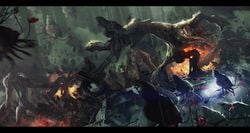
- Main article: Outbreak on Installation 00
In early June 2559, after the loss of the Enduring Conviction, the Jiralhanae brothers Pavium and Voridus were tasked to salvage the wrecks around High Charity for weapons to use in the conflict with the humans of the UNSC Spirit of Fire. The Banished leader Atriox, aware of the potential danger of the Flood having survived in the city, gave specific orders to only scout the shell and not to go inside lest surviving Flood be disturbed. However, Voridus, like many of the Banished, did not take the threat of the Flood seriously, believing it simply be another lie of the Prophets. Ignoring the warnings of both Atriox and his own brother Pavium, Voridus deactivated the Ark's Sentinel defense network and used a Barukaza Workshop Scarab to burn a hole in the containment shield around the former Covenant holy city. When Voridus' troops entered the wreckage to salvage it, they were ambushed by thousands of Flood infection forms lurking within High Charity which were then set loose upon the Ark. With the Sentinel defense network down, the Flood were left unhindered by the Ark's defense systems.[51]
Pavium quickly assembled a force to rescue his brother, defending against overwhelming Flood forces before finally retreating to meet up with Voridus at a Banished drill site near a Forerunner archive that contained a control terminal for the Sentinel defense network.[52] As the area was honeycombed with fissures filled with unstable explosive power, Pavium managed to use Banished Salvage Drills to start a chain reaction to burn away the majority of the Flood in the area, allowing Voridus to access the archive.[53] Inside, despite heavy Flood resistance, Voridus and his troops managed to reactivate the Sentinel defense network which began to cleanse the Flood.[54] However, by this time, the Flood had created a massive Proto-Gravemind in the area near High Charity that was in danger of becoming a full-fledged Gravemind while the threat from the Flood forced Atriox to pull back from positions he had established to fight the humans.[50] This Proto-Gravemind retained a measure of the deceased Gravemind's intellect, but the Gravemind's new vessel had to feed and spread in order for the Gravemind to fully manifest once again.[55] Voridus, Pavium and Banished forces, with the help of the Ark's defenses, in particular a Retriever Sentinel, managed to kill the Proto-Gravemind before it could become a Gravemind.[50]
With the Proto-Gravemind dead, the Flood threat was greatly diminished. Atriox ordered Pavium and Voridus to clean up their mess and the Banished joined a force of thousands of the Ark's Sentinels in containing the Flood outbreak and sealing off High Charity once more.[50] The Banished and the Sentinels ultimately ended up "scouring" the Flood from High Charity's ruins.[56]
Flood forms
The Flood is composed of a variety of specialized forms, each filling a different role in combat. The most basic Flood forms are the infection forms, which come in various types and infect hosts by hijacking their bodies and nervous systems.[57] Infected hosts then undergo a rapid series of transformations, becoming lethal combat forms. Combat forms are used to subdue and secure additional hosts for infection, and once they have outlived their usefulness as warriors, they transform into carrier forms, spreading the Flood by spreading more infection forms.
Once the Flood has amassed enough bodies to create a Gravemind, it is capable of generating "pure" forms, which are created solely from assimilated nutrients and biomass. The pure forms observed during the outbreak in late 2552 were able to spontaneously mutate between three configurations: Stalker, Tank and Ranged forms, although in practice the true extent of their mutability is impossible to effectively catalog.[58]
The Flood at this point relegate the combat forms to defensive purposes or as additions to the biomass, calcium, and nervous system reserves of the Flood hive, and rely increasingly on the pure forms as their primary instrument of infantry force. However, in order for the pure forms to fully replace the combat forms, the pure Flood population must be large enough and in a state of equilibrium, which is in a constant state of flux depending on Flood gains and losses. Because of this, it is common for the combat forms to serve alongside the pure forms, in addition to the infection and carrier forms, as the acquisition of hosts and technology would likely outstrip the speed in which the Flood can generate pure forms.
Spores
- Main article: Flood spore
Spores are minuscule airborne Flood forms that serve to spread infection and suffocate potential hosts who inhale them.
Infection forms
Infection forms are the most basic category of the Flood parasite, consisting of several varieties of both ground- and airborne Flood forms.[57]
Tadpoles
- Main article: Flood tadpole
Pod infectors undergo a tadpole phase of development before growing into full physical maturity.[59]
Pod infectors
- Main article: Pod infector
These are among the most basic of Flood forms. They are tasked with seeking hosts, then infect them that mainly on the ground.
Seeder infectors
- Main article: Seeder infector
These are airborne forms of Pod infectors that mainly tasked with infecting airborne creatures.
Pure forms
These forms are the natural flood form and are produced depending on need and amount of biomass available.
Tank form
- Main article: Pure form
These large tanking forms can only be produced when a Flood outbreak has amassed considerable amounts of biomass and formed a Gravemind. These forms can take and deal massive amounts of damage.
Ranged form
- Main article: Pure form
These flood forms can only be produced once a Flood outbreak has obtained enough biomass to form a Gravemind. These forms attack via bony spikes shot from it's back area, however is immobile.
Stalker form
- Main article: Pure form
These pure forms can only be produced if a Flood outbreak has gathered a large quantity of biomass to creat a Gravemind. These forms are very fast and agile.
Infester Forms
- Main article: Flood infester form
These forms attack and infect vehicles.
Carrier forms
These forms of the flood produce various Flood forms.
Carrier form
- Main article: Carrier form
These bloated forms incubate Pod infectors, and release them upon death.
Spawner Forms
- Main article: Flood spawner form
These forms can produce a variety of Flood forms on the move.
Flood burster
- Main article: Flood burster
These forms can produce a variety of Flood forms and release them once its internal pressure has reached a certain point.
Combat forms
- Main article: Combat form
Once a host of any organic/sentient species has been infected, they can develop into a combat form.
Key minds
- Main article: Key mind
Key minds are nodes for the Flood's collective consciousness, ranging from mobile coordinating forms to compound minds spanning entire planets.[24]
Juggernaut
- Main article: Flood Juggernaut
The Flood Juggernaut is a large Flood command form directed by a seething mass of infection forms linked to multiple hosts.
Abomination
- Main article: Abomination
The Abomination is a mobile, low-level key mind form capable of combat that coordinates the Flood on a local scale.
Proto-Gravemind
- Main article: Proto-Gravemind
A biomass of hosts, for the purpose of utilizing their minds to form a collective intelligence. A Proto-Gravemind can grow into a Gravemind given enough time and host bodies.
Gravemind
- Main article: Gravemind
This ultimate Flood form serves as the coordinating hive mind of the Flood. While they vary in size and complexity, at their height Graveminds can engulf entire worlds.
Biology
The Flood is an anomaly in all known biology; their mode of growth and reproduction would make them incompatible with any natural ecosystem.[3] They are extremely adaptive, and transform hosts to suit the species' current needs.
Capable of surviving extreme environments ranging from -75 to +53 degrees Celsius and even underwater, the Flood can withstand the varied environments of all known inhabited planets. However, the Flood seem to thrive the most in moist and humid areas; it is thought that the extremely cold artificial weather patterns near certain important areas of the Halo rings are intended to hinder the Flood. [citation needed] In order to give themselves ideal living conditions, the Flood will transform the environment to better suit their needs, altering the atmosphere and covering solid surfaces with Flood biomass.
All Flood biomatter is made of a unique, undifferentiated "Super Cell", which relays information and coordinates the cellular assembly like conventional neural cells. It is also capable of flexing and moving in coordination with other cells, and can be arranged to mimic any bodily organ that is required for the Flood's use. This combination of traits has caused some to refer to it as "thinking muscle."
The Flood Super Cell physically resembles both neuron and glial cells in structure, with a central cell body and many tendril-like, branching structures.
Infection

In order to reproduce and grow in biomass, the Flood needs to infect and assimilate other life-forms. While capable of infecting nearly any organism, the Flood shows a strong preference for sentient life-forms, as assimilating their cerebral tissue allows the Flood to increase its overall intelligence.
The first stage of a Flood outbreak is typically initiated by contact with Flood spores or even more reduced forms of Flood biomatter, should no extant Flood forms be present.[58] Once a basic infestation has been established, Flood infection is typically carried out by Pod infectors, which are some of the most complex forms that can be generated from Flood biomass during the Feral Stage. Upon sighting a host, a Pod infector will leap for the most accessible area of the victim's torso; if the target is an armed human or other bipedal species, this is typically the left side of the chest below the neck, as most combatants will expose this area while shouldering their weapon.[60] Upon contact, the Pod infector will rasp away at clothing and flesh until it has burrowed into the chest cavity, mortally wounding them. As the host dies, the Pod infector extends tentacles that tap into the victim's spinal cord or other nerve center, forcing a "match" with the nerve signals previously produced by the host's living brain.
To begin the physiological conversion of a host, the Pod infector injects encapsulated Flood Super Cells into the body. As it does so, the form analyzes the entire genetic code of its host, allowing the Flood to determine the most effective use of the victim. Simultaneously, the inserted Flood cells capture and break down the host body's cells into organic raw material, which is then absorbed and assimilated into the attacking Flood cells.
The Flood infection then uses the absorbed biomass to create new masses of Flood Super Cells. As the Flood continues to use the resources of the host body, particularly its calcium reserves, the parasite's own cells build upon and augment the framework of the host to produce one of a variety of Feral-Stage Flood forms. This entire process, from the initial kill to total control over a fully mutated host body, takes only a matter of seconds.[61][62]
The infection process is not limited to living hosts; organisms that are already deceased are also susceptible to infection. As long as the host has not decomposed to the point where the body and nervous system have completely deteriorated, the Pod infector can infect and convert the host.
The Flood infection utilizes the host's biological content as the fuel for its work, which is consumed and employed at prodigious speeds. From the beginning until the end of this complex, multi-step process, the Pod infector keeps the body "alive" by chemically isolating the host's dying brain, preventing the signals of brain death from reaching the rest of the body and causing it to shut down, which is an essential part of the parasite's mission of consuming and converting the host organism.[63]
While the Pod infectors are an effective and economical means of delivering infection, particularly against armored targets, the Flood can infect hosts through other means. Flood spores, if inhaled, can transform a host into a combat form. This is the Flood's primary means of infection when an outbreak reaches a certain point: Flood spores will be deployed into a local biosphere in copious quantities, instantly overwhelming any unprotected biological targets.[64] Flood conversion may also be initiated through contact with lacerated tissue, making any Flood form a potential vector for infection.[35] Even the most basic form of Flood genetic material is virulent; once inserted into a host, it will mutate the host's DNA over the course of generations until it is capable of forming its own Flood super cells.[65] When infected by these mechanisms, host organisms tend to mutate at a more restrained level that maintains the structure and form of the infected life form, albeit with a significant number of haphazardly placed tendrils, claws, and minor organs, such as sensory stalks.[66]
Neurological
Pod infectors selectively target species that possess sentient intelligence and are of sufficient biomass, and can infest intact or lightly wounded dead bodies. As a host organism is killed by the initial attack, Pod infectors use tendrils that pierce the skin of the host and find their way to the spinal cord. They then synchronize with the host's nervous system and gain control of their body, replacing its now-absent consciousness with the ravenous and voracious psyche of the Flood. Any useful information present within the memory centers of the host's brain, such as battle strategies and technical knowledge, is retained for use by the Flood. Despite this lingering of certain memories, no trace of the original mind remains; only a simplistic and primal urge to assimilate other species drives the organism after infection. However, the entirety of the host's mental content is seemingly absorbed and added to the whole, as the Gravemind has shown to be able to simulate its victims' consciousnesses within itself.[38][67]
In isolated cases, such as when the Flood seek very specific information from an individual's mind, they utilize an alternate method of infestation that does not subdue the host's consciousness immediately despite mutating their physical form; this allows the Flood to "burrow" into the host's mind, eventually giving them access to the entire scope of the host's memories. This has only been specifically seen when the Flood sought information from Captain Jacob Keyes, such as the location of Earth, or a starship that would free them from Installation 04.[68] In addition, if the Pod infector that initiates assimilation is extremely aged or damaged somehow, the host may remain alive and conscious; Private Wallace Jenkins suffered such a fate, remaining alive and fully aware of his situation despite the mutation of his form, even exhibiting limited control over his body at times when the Flood instincts were dormant.
When the Flood have amassed enough sentient hosts to form a Gravemind, then their behavior becomes far more coordinated, and the Flood collective becomes much more deadly as a result. The Gravemind may also speak directly through combat forms and pure forms under its control.
Physiological
While baseline neurological assimilation is the same regardless of host species, the Flood infection process includes physiological transformations, which vary depending on the host and the Flood's present need for specialized combatants.
Upon being infected, higher-level species capable of combat are typically transformed into combat forms. The host's physiology is completely "rewritten" during the infection process: organ-based systems are corrupted, organ-specific functions are decentralized, and body cavities are decayed, making hitbox-selective incapacitation impossible and brute force incapacitation difficult. Due to the lack of a central nervous system, decapitation will neither stop nor slow a combat form.
Furthermore, munitions with high speed and penetration, such as sniper rifle rounds, are usually ineffective against combat forms. Picking off selective areas of a combat form leads to no wide-scale physiological impediments, and the projectile will punch through the decayed flesh rapidly, exiting through the other side of the combat form without dealing any major damage.
To facilitate melee combat, combat forms generate tentacles and claw-like structures, which protrude from the host's arms. Generally, a single arm develops into a clawed appendage, while the other retains the capacity to manipulate objects, such as firearms. The rapid growth of these structures tends to push aside and break apart the host's hands and forearms.
Combat forms can strike with devastating force, move with tremendous speed and agility, and jump to great heights, displaying physical abilities far beyond those of the host organism while it was alive.
The price for these formidable abilities is that the required metabolism is so rapid and extreme that the host organism's corpse is rapidly broken down by the parasite. This is dramatically demonstrated by the rapid decomposition and disintegration of an infected life-form, which will eventually become a stunted, bloated, mobile generator and incubator for more Pod infectors, which is commonly known as a carrier form.
Pod infectors and pure forms sense their surroundings using specialized tentacles, which are tipped with red ganglia. Exactly how these organs work is unknown; they may provide visual or chemical information, or perhaps a combination of both. In combat forms, these tentacles typically protrude from the chest cavity where the Pod infector is housed; in pure forms, they are located on the front of the "head" segment.
The described changes occur when the Flood has still yet to overwhelm any meaningful resistance in a given locale. When this has been accomplished, available organisms will no longer be used to create purpose-built combat forms but are instead used to create a Gravemind or simply broken down and processed into biomass for a Flood hive.[35][64]
Metaphysical and technological
- "The Flood changes everything. Not just flesh. Space itself is infected. That's the power the Precursors once had... isn't it?"
- — The Ur-Didact to the IsoDidact.[69]
Although the Flood is biological on the most basic level, as an outbreak advances, it becomes a highly powerful self-replicating swarm which will seek to harness any mechanism — philosophical, ideological or technological — to perpetuate itself and its goals. These aspects were most prominently demonstrated during the two major outbreaks in the Forerunner era, particularly the Forerunner-Flood war.[70]
The Flood's most notable meta-biological aspect is the logic plague, an abstract infection carried along information transmission and exchange, typically used to subvert AIs. Mechanisms used to perpetuate this infection range from subtle philosophical persuasion through mutual conversation to more predatory techniques, such as swarming AI networks with a self-replicating information infestation with the ability to convert most machine intelligences near-instantaneously. In the later days of the Forerunner-Flood war, the Flood was able to spread the logic plague through any of its biological forms or infected ancillas.[70]
During its war with the Forerunners, after accumulating sufficient intellectual capacity and processing power in the form of several planetary Key Minds, the Flood gained the ability to manipulate neural physics, which served as the foundation of Precursor technology.[23] This enabled it to control the Precursors' formerly dormant structures—most prominently star roads—and use them as weapons against the Forerunners, as well as manipulate space-time to become incompatible with Forerunner slipspace travel. On a more abstract level, the Flood's connection to neural physics caused the Forerunners to experience the very space-time around them as being increasingly hostile.[69] Upon the development of a Gravemind, the Flood becomes capable of what can be described as telepathy among its hosts;[3] given the Flood's origins, this ability may be related to neural physics.
The Flood is able to use any technology it has assimilated, often to a superior degree than the original creators of said technology due to its vast base of knowledge and intellect, as evidenced by its ability to transition the UNSC frigate In Amber Clad into High Charity with a precision slipspace jump normally unheard of with human ships. Similarly, it was capable of tapping into Installation 05's teleportation grid and utilizing it with great accuracy.[38]
Developmental stages
A Flood infestation goes through four distinct developmental stages:
- During the Feral stage, the Flood are at their simplest form: they communicate via pheromones and have the instinct to harvest enough calcium to establish a viable Gravemind.[3]
- The Flood become truly dangerous during the Coordinated stage: at this point, they are controlled by the Gravemind that was created in the first stage.[3]
- In the Interstellar stage, the Flood take control of space-faring technology which they use to consume the local star system. Subsequently, they spread throughout the galaxy to infect more hosts.[3]
- The Transgalactic stage is a theoretical stage in which the Flood utilizes all captured technology to depart to uninfected galaxies to further replicate.[3]
| |||||||||||||||||||||||||||||||||
Countermeasures
Small-scale
There is no confirmed way to effectively stop a Flood infection once Flood Super Cells have entered a host. The only exception is too rare and factually suspect to be considered viable: the human disease "Boren's Syndrome", a neurological condition where radiological exposure causes electrical anomalies in the host nervous system, allegedly renders the host immune to infection while living. The neural frequencies of the host are "scrambled", apparently without negative consequences to the host. However, during Flood infection, the Pod infector is unable to tap into the host's nervous system, rendering it incapable of proceeding to large-scale physiological mutation. An interesting side effect of this failed infection is that Flood DNA and cells appear to be harmlessly integrated into the host's body. This seems to provide the host with increased regenerative capabilities, although this has not been independently verified. While Boren's syndrome left untreated may render the victim immune to the Flood, leaving it untreated almost always equates to death within a couple of years. There is said to be a "one in a billion" chance that research into the disease could produce a cure.[71] However, the accuracy of this information remains highly dubious, as most of it is simply a hypothesis devised by Dr. Halsey to explain how Avery J. Johnson survived Flood infection. Johnson's "Boren's Syndrome" was actually a story invented to cover his past in the ORION Project: his symptoms were side-effects of his experimental enhancements, not a neurological disease.[72]
While the Forerunners could not find a cure for Flood infection, the Composer was designed to eliminate its effects by extracting a Flood victim's consciousness into digital form and then re-inserting it in an artificially-constructed body devoid of infection. However, the Forerunners never perfected this process and any imprinted bodies died soon after,[73] due to the Flood somehow resuming the infection in the new body. The Forerunners attempted to use various means to slow down this process, including a specially designed harness of mesh and wires, which would apparently counteract the infection. The victim would retain most or all of their mental faculties and self-control, although their body would continue to be mutated by the Flood. This countermeasure was only temporary, however, and the victim would eventually either decay and die or be fully subsumed by the Flood. Several Forerunners on Installation 07 were subjected to this countermeasure.[74][75]
Although initially used to treat those with small-scale Flood infection already present, the Composer was eventually used by the Ur-Didact to convert his Prometheans, as well as a large number of humans, into AI constructs for his war machines, in an effort to combat the Flood more effectively and without risk of infection.[16]
Large-scale
Since the Flood are a parasitic life form, they depend on other organisms for survival. Thus, the most effective way to stop a large-scale infestation is to take away their food sources. The Forerunners first attempted this by bombing large population centers and destroying inhabited star systems via supernovae, but this was seen as one of their last resorts and as such was performed too late in the war to make much difference. The last resort was the use of the Halo Array, which destroyed all sentient life in the galaxy and starved the Flood into extinction. However, the Forerunners' plan included some measures to preserve sentient life and return them to their home planets, allowing the Flood's "food source" to persist. Unfortunately, at the same time, specimens of Flood spore cells were kept for analysis on the Halo installations, allowing the threat of the Flood to be merely forestalled and not eradicated.
Environmental stimuli seem to have an effect on Flood metabolism. In the event of a Flood outbreak, Halo installations create a quarantine zone around the affected area,[76] inside which the ambient temperature is drastically lowered. At least one Flood research facility used low temperatures to keep its specimens inactive and dormant as it studied them.[77] At least one of the Halo installations' Control Rooms was located in a snowy environment, possibly to hinder escaped Flood in their attempts to reach it.
The Flood are also vulnerable to temperatures on the other end of the spectrum. plasma weapons will easily burn through Flood tissue; the Forerunners incorporated directed-energy weapons into their Sentinels, indicating that they had determined high-enthalpy energy weapons to be the best 'basic countermeasure' available to fight the Flood. Known examples of Forerunner personal weaponry appear to be geared toward the disintegration of organic matter,[78] also reflecting the Flood's vulnerability to extremely high temperatures. The UNSC has taken advantage of this weakness as well, making heavy use of flamethrowers in their engagements with the Flood.
When engaging heavily entrenched Flood structures such as colonies and Cocooned bases, orbital bombardment is usually a preferred method of elimination as direct attacks can be extremely costly.[79]
The "cure"
During the human-Forerunner wars, humanity (who at the time was a technologically advanced, spacefaring race) believed they had discovered another way to defeat the Flood. Using genetic engineering, a third of the human population was altered to carry a set of specially designed genes. This group of humans was then allowed to be infected by the Flood. Once the genes were exposed to Flood DNA, they triggered a cascade of cell destruction that spread throughout all Flood biomatter. The majority of the Flood died off as a result, although they would return in full force ten thousand years later. All information regarding this "cure" was destroyed by the humans as a final act of revenge against the Forerunners, leaving them unprepared for the second Flood strike.[80]
In reality, while humanity's efforts indeed produced the intended result and repulsed the Flood threat, it was later revealed by the Primordial that the Flood retreated by its own initiative, as humanity was not yet to be "tested" by the Flood. As such, humanity's survival was in fact due to the Flood's deliberate decision not to infect human populations, as the Precursors had determined to use the Flood to punish the Forerunners first.[18]
After the Flood began to ravage the Forerunners' ecumene, Forerunner scientists led by Master Builder Faber tried in vain to extract information on the cure from humans' ancestral memories, imprinted as part of their geas by the Librarian, unaware that the cure never really existed.
Combat behavior
The Flood's combat strategy is simple: they throw themselves at potential hosts in huge numbers and with any and all weapons available. The parasite seeks to saturate its opponents with an excess of noise, so thoroughly it impedes the enemy's ability to process information and prevents them from organizing a meaningful resistance.[21] The Flood exhibits this behavior on all levels, from its physical swarm tactics in both ground and space to its corruption of data networks and, once an outbreak has progressed far enough, space-time itself.[69]
Flood tactics are based primarily on asymmetrical warfare, using various different forms to kill and infect enemy forces. Infection forms swarm across the battlefield in waves, reanimating any corpses and victims they can find, while combat forms attack and kill any living hosts in sight. Pure forms, if present, provide support to combat forms in a number of ways: Stalker forms move to strategic positions and mutate into either Tank or Ranged forms, which can destroy enemy vehicles or fortifications or provide suppressing fire from afar.
The Flood have a strong preference for close-range combat: combat forms possess extremely powerful melee capabilities due to their specialized claws and tentacles, and are capable of bringing a suit of MJOLNIR armor's energy shields to half strength with a single strike. Exploding carrier forms cause tremendous damage at close range, with the added benefit of spewing Pod infector in the immediate vicinity of enemies. Pod infectors are capable of attacking only at point-blank ranges, exploding in damaging bursts when meeting an opponent's personal energy shields or instantly grabbing hold of an unshielded enemy organism and infecting it.
Combat forms can also use firearms, and have been seen clutching them in one of their hands (regardless of whether it is one-handed or two-handed). However, combat forms are very inaccurate when using ranged weaponry; it is believed that the neurological and physical effects of Flood infection significantly decrease accuracy.
The Flood collectively learn any information contained within the minds of their sentient hosts. For example, during the ill-fated raid on the Infinite Succor, after even one Sangheili was assimilated, all the Flood could open any doors and access any system on the ship immediately afterward, demonstrating the Flood's ability to share collective knowledge across their species. Furthermore, when the Flood assimilated the Prophet legate, the Minister of Etiology, the Flood reflected the high-level knowledge of the Legate through its individual organisms to Special Operations Commander Rtas 'Vadumee, mocking him with the words, "the Forerunner could not defeat us...what chance you?". The Flood, however, reflect unusual knowledge in the individual psychologies of its individual species in processes facilitating increased infestation: The Flood were sighted gathering bodies in the corners of the Covenant ship Truth and Reconciliation, perhaps making it easier for infection forms to find hosts to reanimate. The Flood were also gathering body parts for a new proto-Gravemind aboard the Infinite Succor.
Flood combat forms have been sighted crudely operating Karo'etba-pattern Ghosts, Warthogs, Wraiths, and Scorpions in ground operations, although with slow deliberation and clumsy driving and accuracy. The assimilated crewmen of the UNSC frigate In Amber Clad were also able to initiate a Slipspace micro-jump for the frigate and perform rudimentary maneuvering of the In Amber Clad, navigating the frigate from the atmosphere of Delta Halo to High Charity and then crashing the vessel into a tower, releasing Pelican dropships to rain down upon the Covenant capital.
While one of the Flood's main strengths lies in the decentralization of its compound mind and ability to be reborn from even the most carefully reduced remnant, it is nonetheless known to develop and assume a certain "core" Gravemind as an embodiment for its strategic intelligence. The Forerunners observed that the Flood exhibits a seemingly instinctive tendency to recoil and concentrate all of its otherwise distributed assets around this core when threatened on a large scale. A threat to the Flood's existence major enough to prompt such action was the imminent firing of the Halos, at which point the Flood gathered all of its available assets and launched an attack on the Ark.[81]
The Flood is very effective on a psychological level, as its parasitic nature and gruesome appearance alone are a source of horror for most of its enemies and thus serve as powerful demoralizers. It is not uncommon for survivors of Flood encounters to be severely traumatized, often to the point of delirium, after witnessing their comrades get infected or being subsequently forced to kill said infected individuals.[82][83]
Notable victims
Non-canon and dubious canon appearances
Silver Timeline
| This article contains information about the Silver Timeline, and is not a part of the established Halo canon. |
- Kwan Ha: "What is it?"
- The Mother: "It is the cohesion. The meaning. The final equilibrium. This is the end. This is the Flood."
- — The Mother reveals the monster's true identity.[84]
The Mother repeatedly warns Kwan Ha of a "monster" that is approaching in visions.[85][86]
After accessing a Forerunner site on Onyx, Kwan, Dr. Halsey, and Miranda Keyes are shown a star map documenting the Flood's spread, causing Kwan to realize that the monster is real.[87]
An overeager biologist named Janine Caryyew inadvertently releases Flood spores from within a sample container collected by Kwan, Halsey and Miranda, unleashing the Flood throughout the Onyx base. The Flood quickly consumes and converts most of the base's personnel, including Admiral Margaret Parangosky. While Halsey is infected, Miranda places her mother into stasis in the hopes of finding a cure. Kwan, Soren, Kessler and Ackerson manage to escape thanks to the intervention of the Mother who warns Kwan of the true nature of the Flood, but Laera remains behind after getting infected.[84]
Gameplay
- Main article: The Flood/Gameplay
Changes from Halo: Combat Evolved to Halo 2
- In addition to making low growls, the Flood make screeches and roars, which were not present in the first game.
- Their skin is more textured due to the improved graphics engine, giving the Flood a more realistic and necrotic look. The faces of the human forms are also more readily recognizable.
- If a combat form has both arms shot off, it will walk slowly then explode, releasing the Pod infector that was controlling it. This eliminated the Flood Buddy glitch.
- Rather than having to "gather bodies," the Flood can seemingly infect hosts over the course of a few minutes or even a few seconds, once again possibly due to the presence of the Gravemind, eliminating the need to gather bodies to form one.
- Rather than corpses reanimating themselves, a Pod infector will enter the body, then reanimate it, even if the form was just eliminated.
- If the player is attacked by a Pod infector while their shields are down, the character will die instantly. In Halo: Combat Evolved, it would simply take a bar of health away.
- Some combat forms derived from Elites still have functional energy shields. However, they never possess active camouflage, as some in Halo: Combat Evolved's final level did.
- Flood combat forms can use vehicles, albeit clumsily, and are also able to board the player's vehicle; they will then proceed to melee the player character and pull them from the vehicle.
- Melee attacks do little to no damage against the Flood in Halo: Combat Evolved. They deal a bit more damage in Halo 2.
- The Flood prefer to stay back and fire on the player rather than rush him. This could be because of the presence of the Gravemind, though, from a gameplay perspective, it is due to improved artificial intelligence.
- In Halo: Combat Evolved a combat form would walk slowly when shooting at the player. When losing the arm that shoots, it would charge the player character. In Halo 2, combat forms either use a melee attack or shoot at the player in these situations.
- If a player is wielding an energy sword or shotgun, a combat form may retreat. They will not do this if a player is wielding other weapons.
- Unlike in Halo: Combat Evolved, shooting one Pod infector will not result in the rest of the swarm exploding with it. However, Pod infectors are encountered in proportionally smaller numbers in comparison to Halo: Combat Evolved.
- Pod infectors appear noticeably less textured and detailed than in Halo: Combat Evolved.
- Flood Combat Forms do not "feign death" anymore.
- Splattering become more difficult as the Flood can use the vehicle momentum to hijack the vehicle.
Changes from Halo 2 to Halo 3
- Brutes may now be infected and transformed into combat forms.
- Melee attacks and plasma weapons were nearly useless against the Flood in Halo: Combat Evolved and Halo 2, but now can be used effectively against the Flood. The Flood are much more vulnerable to ballistic weapons, as well.
- Pod infectors can mutate humans, unshielded Elites and Brutes into combat forms within seconds (as seen during Floodgate).
- Pure forms are introduced.
- Combat forms wield weapons far less frequently than in Halo: Combat Evolved and Halo 2.
- Carrier forms release significantly more Pod infectors when they explode. The explosion does not push the player away much as in Halo: Combat Evolved and Halo 2. In addition, carrier forms are significantly more difficult to kill with projectile weapons, but they are easily destroyed by plasma weapons.
- Running over Pod infectors while driving a vehicle can result in loss of steering and possibly overturning of the vehicle. Any Pod infectors that are hit by the vehicle will not pop.
- Flood combat forms can no longer commandeer vehicles, like they could in Halo 2.
- Sticking a carrier form with a Anskum-pattern plasma grenade or Spike Grenade will kill both the carrier form and the pod infectors it carries. This is also true of a supercombine explosion.
- Any weapon wielded by humans, Elites, and Brutes will not be dropped when transforming into combat forms and the combat forms will be also unarmed.
- Any humans, unshielded Elite, and Brutes have a low chance to resist or preventing the Pod Infector from infecting them.
- Any Pod infector latching into surviving humans, Elite, and Brutes before the infection can be shot at to prevent infection.
Changes from Halo 3 to Halo Wars
Significant changes to the Flood's general existence were necessary due to the change of genre from first-person shooter to real-time strategy game. These are as follows.
- Many new forms, such as bomber forms, were created for Halo Wars to expand the "roster" of Flood units. The official explanation is that these forms were created from creatures indigenous to Trove.
- Combat forms have more tentacles than before; they resemble spikes rather than flexible appendages.
- Grunts and Jackals can be converted to combat forms.
- Pod infectors do not explode when they are shot in the cinematics, instead 'deflating' like punctured balloons, though they still explode in gameplay.
- Carrier forms do not always explode upon death.
- Hero Units that do not have shields will be instantly downed regardless of any remaining HP on them, featuring an instant kill on any enemy infantry without energy shielding.
Changes from Halo Wars to Halo Wars 2
- The Flood now has a Super Unit, The Abomination.
- New forms are introduced, such as Flood spawner forms, which can spawn Flood forms on the move and can spawn counter units.
- The Flood now only infects the Squad Leader(Either Jiralhanae or Sangheili depending on the Leader) in a Grunt Infantry unit, while the rest are killed. Marine units are entirely infected, retaining Halo Wars infection traits for humans.
- Pod infectors can now be killed more effectively with units that deal splash damage.
- The Flood can now infest and commandeer vehicles that are still operational, except Super Units and mechanical units (Mainly Sentinels).
- Seeder infector, a new variety of Infection Form that is able to infect air units, is introduced.
- Flood infestor, a new kind of pure form, is introduced and specialized in infecting the vehicles.
- Infected mechanical vehicles are immune to Isabel's Ghost In The Machine Leader Power.
- Turret defenses have had their effectiveness reduced against Pod infectors, even those equipped with anti-infantry upgrades.
- Mega Turret and Siege Turret were exempted from this due to providing splash damage.
- The infection process affects all units. If the Pod Infector units doesn't match its victim (For example, Pod Infestor attacks infantry unit is not match for infection), it will be destroyed or killed. If match, the infection process can be started.
- Any infected units will revert their health back to 100% once the infection process has been completed.
- Infection process can be started once a unit is dying (Red Health).
- New structures for barricades are introduced.
- Pod infector squad size increased 3 to 4 times.
- Biohazard sign appears every time a unit has gotten infected.
Gameplay
- Main article: The Flood/Gameplay
Changes from Halo: Combat Evolved to Halo 2
- In addition to making low growls, the Flood make screeches and roars, which were not present in the first game.
- Their skin is more textured due to the improved graphics engine, giving the Flood a more realistic and necrotic look. The faces of the human forms are also more readily recognizable.
- If a combat form has both arms shot off, it will walk slowly then explode, releasing the Pod infector that was controlling it. This eliminated the Flood Buddy glitch.
- Rather than having to "gather bodies," the Flood can seemingly infect hosts over the course of a few minutes or even a few seconds, once again possibly due to the presence of the Gravemind, eliminating the need to gather bodies to form one.
- Rather than corpses reanimating themselves, a Pod infector will enter the body, then reanimate it, even if the form was just eliminated.
- If the player is attacked by a Pod infector while their shields are down, the character will die instantly. In Halo: Combat Evolved, it would simply take a bar of health away.
- Some combat forms derived from Elites still have functional energy shields. However, they never possess active camouflage, as some in Halo: Combat Evolved's final level did.
- Flood combat forms can use vehicles, albeit clumsily, and are also able to board the player's vehicle; they will then proceed to melee the player character and pull them from the vehicle.
- Melee attacks do little to no damage against the Flood in Halo: Combat Evolved. They deal a bit more damage in Halo 2.
- The Flood prefer to stay back and fire on the player rather than rush him. This could be because of the presence of the Gravemind, though, from a gameplay perspective, it is due to improved artificial intelligence.
- In Halo: Combat Evolved a combat form would walk slowly when shooting at the player. When losing the arm that shoots, it would charge the player character. In Halo 2, combat forms either use a melee attack or shoot at the player in these situations.
- If a player is wielding an energy sword or shotgun, a combat form may retreat. They will not do this if a player is wielding other weapons.
- Unlike in Halo: Combat Evolved, shooting one Pod infector will not result in the rest of the swarm exploding with it. However, Pod infectors are encountered in proportionally smaller numbers in comparison to Halo: Combat Evolved.
- Pod infectors appear noticeably less textured and detailed than in Halo: Combat Evolved.
- Flood Combat Forms do not "feign death" anymore.
- Splattering become more difficult as the Flood can use the vehicle momentum to hijack the vehicle.
Changes from Halo 2 to Halo 3
- Brutes may now be infected and transformed into combat forms.
- Melee attacks and plasma weapons were nearly useless against the Flood in Halo: Combat Evolved and Halo 2, but now can be used effectively against the Flood. The Flood are much more vulnerable to ballistic weapons, as well.
- Pod infectors can mutate humans, unshielded Elites and Brutes into combat forms within seconds (as seen during Floodgate).
- Pure forms are introduced.
- Combat forms wield weapons far less frequently than in Halo: Combat Evolved and Halo 2.
- Carrier forms release significantly more Pod infectors when they explode. The explosion does not push the player away much as in Halo: Combat Evolved and Halo 2. In addition, carrier forms are significantly more difficult to kill with projectile weapons, but they are easily destroyed by plasma weapons.
- Running over Pod infectors while driving a vehicle can result in loss of steering and possibly overturning of the vehicle. Any Pod infectors that are hit by the vehicle will not pop.
- Flood combat forms can no longer commandeer vehicles, like they could in Halo 2.
- Sticking a carrier form with a Anskum-pattern plasma grenade or Spike Grenade will kill both the carrier form and the pod infectors it carries. This is also true of a supercombine explosion.
- Any weapon wielded by humans, Elites, and Brutes will not be dropped when transforming into combat forms and the combat forms will be also unarmed.
- Any humans, unshielded Elite, and Brutes have a low chance to resist or preventing the Pod Infector from infecting them.
- Any Pod infector latching into surviving humans, Elite, and Brutes before the infection can be shot at to prevent infection.
Changes from Halo 3 to Halo Wars
Significant changes to the Flood's general existence were necessary due to the change of genre from first-person shooter to real-time strategy game. These are as follows.
- Many new forms, such as bomber forms, were created for Halo Wars to expand the "roster" of Flood units. The official explanation is that these forms were created from creatures indigenous to Trove.
- Combat forms have more tentacles than before; they resemble spikes rather than flexible appendages.
- Grunts and Jackals can be converted to combat forms.
- Pod infectors do not explode when they are shot in the cinematics, instead 'deflating' like punctured balloons, though they still explode in gameplay.
- Carrier forms do not always explode upon death.
- Hero Units that do not have shields will be instantly downed regardless of any remaining HP on them, featuring an instant kill on any enemy infantry without energy shielding.
Changes from Halo Wars to Halo Wars 2
- The Flood now has a Super Unit, The Abomination.
- New forms are introduced, such as Flood spawner forms, which can spawn Flood forms on the move and can spawn counter units.
- The Flood now only infects the Squad Leader(Either Jiralhanae or Sangheili depending on the Leader) in a Grunt Infantry unit, while the rest are killed. Marine units are entirely infected, retaining Halo Wars infection traits for humans.
- Pod infectors can now be killed more effectively with units that deal splash damage.
- The Flood can now infest and commandeer vehicles that are still operational, except Super Units and mechanical units (Mainly Sentinels).
- Seeder infector, a new variety of Infection Form that is able to infect air units, is introduced.
- Flood infestor, a new kind of pure form, is introduced and specialized in infecting the vehicles.
- Infected mechanical vehicles are immune to Isabel's Ghost In The Machine Leader Power.
- Turret defenses have had their effectiveness reduced against Pod infectors, even those equipped with anti-infantry upgrades.
- Mega Turret and Siege Turret were exempted from this due to providing splash damage.
- The infection process affects all units. If the Pod Infector units doesn't match its victim (For example, Pod Infestor attacks infantry unit is not match for infection), it will be destroyed or killed. If match, the infection process can be started.
- Any infected units will revert their health back to 100% once the infection process has been completed.
- Infection process can be started once a unit is dying (Red Health).
- New structures for barricades are introduced.
- Pod infector squad size increased 3 to 4 times.
- Biohazard sign appears every time a unit has gotten infected.
Production notes

|
Browse more images in this article's gallery page. |
Miscellaneous
- The Flood's AI routines in Halo: Combat Evolved were originally intended to be "every bit as complicated as the Covenant", but full implementation was prevented by time constraints.[88]
References
- The name of the Flood is a reference to the biblical story of the Great Flood. Some of the parasite's history mirrors the story, in which God destroyed all life except for that which was carried by Noah's ark.
- The Flood bear a strong visual resemblance to an enemy cut from Marathon 2, the “fungal zombie.” These were to be the result of a bioweapon invented in the final days of the ancient S'pht and reused by Robert Blake's forces on Lh'owon, designed specifically to target Pfhor. Both the fungal zombies and Flood were principally designed by Robert McLees.
- The Flood were inspired by Christopher Rowley's The Vang.[89]
- An alien virus named "The Flood" appeared in a 2009 special episode of the British science fiction television show Doctor Who. Although like its Halo counterpart, it is hinted to be intelligent, and is extremely virulent, transforming its victims physically, the Flood found on Mars literally uses water to transmit itself.[90] The previous episode, also a special, involved the alien planet "San Helios", a name very similar to Halo's Sanghelios.[91]
Gallery
Early concept art for the Flood by Robert McLees.
A large unidentified Flood form seen in Origins I from Halo Legends.
A Spartan-IV with Flood cosmetics in Halo Infinite.
List of appearances
Sources
- ^ Halo: Primordium, page 53
- ^ a b c Halo 3, campaign level Floodgate
- ^ a b c d e f g h Bestiarum
- ^ Halo.Bungie.Org: Updated and abbreviated list, errors amended
- ^ Halo 2, campaign level The Heretic: "Thel 'Vadamee: "Noble Hierarchs, surely you understand that once the parasite attacked-""
- ^ Halo Wars, campaign level Relic Approach: "Re'gish Wamik: "What if the infection defiles the relic?""
- ^ Halo: Combat Evolved, campaign level Two Betrayals
- ^ a b c d e Halo: Silentium, page 173-175
- ^ Halo: Primordium, page 335-336
- ^ Halo Mythos, page 9
- ^ Halo: Silentium, page 181-182
- ^ a b c d e f g h Halo: Cryptum, page 268-270
- ^ Halo: Silentium, page 35
- ^ Halo: Primordium, page 226
- ^ Halo: Cryptum, page 131
- ^ a b Halo 4: Terminals
- ^ a b c Halo: Silentium, page 34-37
- ^ a b Halo: Primordium, page 364-365
- ^ Halo: Silentium, page 170
- ^ a b c Halo: Cryptum, page 272
- ^ a b c d e Halo 3: Terminals
- ^ Halo Mythos, page 32
- ^ a b c Halo: Silentium, page 186-187
- ^ a b Halo Waypoint: "Canon Fodder - Deluge Delights"
- ^ Halo: Cryptum, page 293-294
- ^ Halo: Silentium, page 326
- ^ Halo 5: Guardians, REQ card: Temple Wraith description
- ^ Halo Encyclopedia (2022 edition), page 224
- ^ Halo Wars
- ^ Halo: Tales from Slipspace: Something Has Happened
- ^ a b Halo: Combat Evolved
- ^ Halo Graphic Novel: The Last Voyage of the Infinite Succor
- ^ a b c Halo: The Flood
- ^ Halo: Combat Evolved, campaign level Keyes
- ^ a b c Halo: Evolutions: The Mona Lisa
- ^ Halo 2, campaign level The Oracle
- ^ Halo 2
- ^ a b c d Halo 2, campaign level Gravemind
- ^ Halo 2, campaign level High Charity
- ^ Halo 2, campaign level The Great Journey
- ^ Halo 3, campaign level The Storm
- ^ Halo 3, campaign level The Covenant
- ^ Halo 3, campaign level Cortana
- ^ Halo 3, campaign level Halo
- ^ a b c Halo: Official Spartan Field Manual, PART 09: ALIEN FACTIONS, The Flood (p. 172-175)
- ^ Halo: Spartan Assault: Flood missions
- ^ Halo 4: The Essential Visual Guide, page 200
- ^ Halo 5: Guardians: Flood visor description
- ^ Halo Wars 2: Phoenix Logs - Idle Hands II
- ^ a b c d Halo Wars 2: Awakening the Nightmare, campaign level Manifestation
- ^ Halo Wars 2: Awakening the Nightmare, campaign level What Could Go Wrong?
- ^ Halo Wars 2: Awakening the Nightmare, campaign level Fighting Retreat
- ^ Halo Wars 2: Awakening the NightmareLight the Fuse, campaign level {{{Level}}}
- ^ Halo Wars 2: Awakening the Nightmare, campaign level The Archive
- ^ Halo Wars 2: Phoenix Logs - Proto-Gravemind
- ^ Halo: Shadows of Reach: Sacrifice
- ^ a b Halo Wars 2: Phoenix Log - Pod Infectors
- ^ a b Halo Waypoint: Flood
- ^ Bungie.net: One Final Effort (4/16/2010)
- ^ Halo: The Art of Building Worlds
- ^ The Art of Halo, page 28
- ^ The Art of Halo, page 50
- ^ The Art of Halo, page 48
- ^ a b Halo: Silentium, page 231-232
- ^ Halo: Cryptum, page 268-270
- ^ Halo Graphic Novel, page 19-54
- ^ Halo: Silentium, page 251
- ^ Halo: The Flood, page 175
- ^ a b c Halo: Silentium, page 223-224
- ^ a b Halo: Silentium, page 214-215
- ^ Halo: First Strike, page 244-246 (2001 edition)
- ^ Halo Graphic Novel: page 122
- ^ Halo: Silentium, page 40
- ^ Halo: Primordium, page 268
- ^ Halo: Primordium, page 322-323
- ^ Halo 2, campaign level Quarantine Zone
- ^ Halo 3: multiplayer level Cold Storage
- ^ Halo 4
- ^ Halo Wars 2: Phoenix Logs - Cocooned Base
- ^ Halo: Cryptum, page 267-272
- ^ Halo 3: Terminal 3
- ^ Halo: Combat Evolved, campaign level 343 Guilty Spark: Paranoid Marine
- ^ Halo 3, campaign level Floodgate: Suicidal Marine
- ^ a b Halo: The Television Series, episode Halo
- ^ Halo: The Television Series, episode Aleria
- ^ Halo: The Television Series, episode Onyx
- ^ Halo: The Television Series, episode Thermopylae
- ^ EDGE magazine - September 2003, page 109
- ^ Gamespot: Halo - Q&A
- ^ Doctor Who, The Waters of Mars
- ^ Doctor Who, Planet of the Dead
| |||||||||||||||||||||||||||||||||

